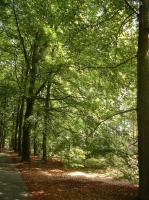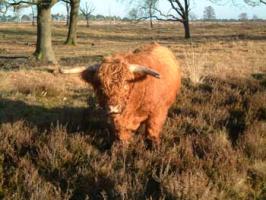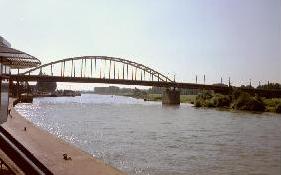(Part of
Wandering in the Netherlands, subpart of
the Hitchhiker's guide of the Elftowners)
Variety of landscapes.
The Veluwe is a forestal ridge of hills in the Dutch province of Gelderland. It's the largest lateral moraine in the Netherlands, reaching heights of over 100 m., while the rest of the country (except the south) lies mostly below sea level. The landscape was formed during the Saalian Ice Age, that began 240,000 years ago, and ended 180,000 years ago.
In the center of the Veluwe region, you can find the Netherlands' biggest national park, the Hoge Veluwe. Here you can find a variety of landscapes, such as woodland, heath, lakes and sand drifts.
The western boundary of the Veluwe is formed by a chain of long, stretched lakes, the eastern boundaries are roughly formed by the idyllic IJssel river landscape, and in the south, the Veluwe borders the
Land van Maas en Waal. This is a region of literally 'fruitful' soil between two big rivers, where one can find many orchards, and it's loved by tourists especially in spring, when the trees are blossoming.
There are pine tree forests, leaf forests, as well as mixed forests on the Veluwe, many of which are royal domains.
 Plant and animal life
Plant and animal life.
Because the landscape is so diverse, more than 500 different kinds of plants grow there. It's also home to a rich wildlife, such as numerous birds, wild boars, several species of deer, rabbits, foxes, badgers and snakes like the viper. The black raven was succesfully re-introduced, and if you are lucky you can spot more exotic species like mouflon sheep, Highlander cattle and the small muntjac deer.

It's not unusual to, during a walk, meet with shepherds and their flocks.
The landscape is intersected by many brooks, created by nature, or by men, in which case they are called
'sprengen'.

In the past, parts of the Veluwe have been seperated from eachother by roads, towns and villages, and farmland, but they are now being reconnected by tunnels underneath and viaducts over the highways, which enlarges the territory of animal species, and helps to increase their genetic diversity. For the same reasons, connecting the Veluwe with the Oostvaarderspl
assen, a wetland in the north, as well as with areas in western Germany, is being worked on. Also several plants that were extinct in this part of the country are now being re-introduced. You will see how parts of the area are being 'given back to nature'. They are freely accessable forestal areas, where men does no longer intervene. It means that, for instance after a bushfire or a storm, the forest is left the way it is, for nature to do its own 'restoration'.
Further 'tourist information' :)
The Veluwe is a popular tourist destination, especially for the dutch people in the over-crowded west who like to 'breathe some fresh air', for a short holiday in their own country.
Beside the beautiful nature, there are several amusement parks, zoos, and over 50 musea. Famous are the Loo Palace in Apeldoorn and the Kröller-Müller museum in the heart of the Hoge Veluwe, with it's big Van Gogh collection, works from Picasso, Mondriaan and Georges Seurat, it's sculpture garden with works from - among others - Rodin, and the bizarre 'Jardin d'émail' by Jean Dubuffet.
The Hoge Veluwe national park has a large network of walking and bicycle routes, so called 'white bicycles' can be used for free, and can be found near every park entrance. A lot more information about the park, also in english and german, can be found here: http://www.hogeveluwe.nl/default.asp?language=2
The Netherlands are an ideal country for walking and cycling, there are cycling paths everywhere, both in towns as on the countryside, and cycling and walking paths criss-cross the forests. There are several on-going long-range routes.
Interesting are also the Berg & Bos park in Apeldoorn (and the monkey park!), the Sonsbeek park in Arnhem, and the "Hidden Village" in the forests near the village of Vierhouten, where between 80 - 100 jews, english pilots, american soldiers, people of the resistance and deserted german soldiers have found a safe shelter during the second World War until they were betrayed.

Part of a hide-out village in the middle of a forest, that was used during the second World War.
Inhabitants and activities.
On the Veluwe, there are many idyllic, sometimes very touristic, villages. People in the northern and western villages are known to be very religious, they are part of the dutch 'Bible Belt', that runs from the north to the southwest of the country. Be aware that on sundays, everything in such villages is closed, people spend most of the day in church, and don't always appreciate to be washed over by crowds of tourists in shorts and T-shirts, so please have a little respect if you decide to go there... Also, the dutch care a lot about nature, so littering, damaging trees and plants, disturbing animals and throwing away your cigarette ends is simply NOT DONE !
In summer, cultural and agricultural markets are organised, mostly on evenings, where regional products (honey!) are sold, and where one can see traditional costumes and handcraft.
Bigger towns like Ede, Apeldoorn and especially Arnhem offer a large variety of monumental buildings, interesting architecture, cafés, restaurants, musea and cinema's.

Bridge over the Rhine river, Arnhem. Made famous by the movie "A bridge too far".
Link to: the Hitchhiker's guide of the Elftowners
Got inspired to check out my country? Maybe you'd also like to visit Wandering in the Netherlands - IJssel Valley and Hunebedden, Dutch dolmens
 Stumble!
Stumble!

